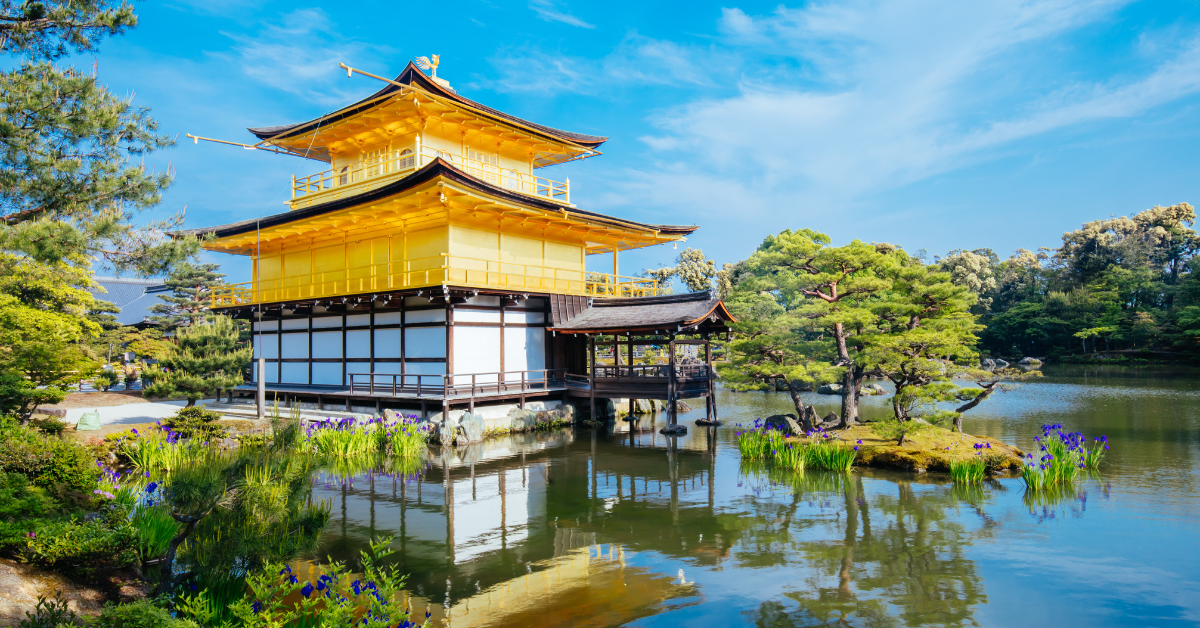Kinkaku-ji, also known as the Golden Pavilion, is one of Japan’s most iconic landmarks. Located in Kyoto, this Zen temple is admired worldwide for its gold-leaf-covered architecture, tranquil gardens, and deep cultural roots. A visit to Kinkaku-ji offers more than just a photo opportunity—it is a journey into the heart of Japanese beauty and spirituality.
- What Is Kinkaku-ji? Understanding Its History and Reconstruction
- The Harmony of Architectural Styles in a Three-Tiered Structure
- The Meaning Behind the Golden Brilliance
- The Beauty of Kinkaku-ji Through the Seasons
- Travel Tips and Etiquette for International Visitors
- Recommended Nearby Spots to Explore (With Cultural Experiences)
- Conclusion
What Is Kinkaku-ji? Understanding Its History and Reconstruction
Kinkaku-ji, officially known as Rokuon-ji, is a Zen Buddhist temple of the Rinzai sect located in Kyoto’s Kita Ward. It was originally constructed in 1397 by Shogun Ashikaga Yoshimitsu as his personal villa. After his death, the villa was converted into a temple in accordance with his will, marking the beginning of its path as a Zen religious site.
The most striking feature of the temple is its gold-leaf-covered exterior, which represents the Buddhist concept of the Pure Land. Rather than a display of opulence, the gold symbolizes spiritual purification and the ideal world. Though the temple was tragically destroyed by arson in 1950, it was faithfully reconstructed in 1955, restoring its former splendor.
The temple grounds feature a traditional strolling garden centered around a reflective pond, where architecture and nature merge to express Japanese aesthetics. Combined with the temple’s golden brilliance, seasonal scenery throughout the year offers new beauty with each visit.
The Harmony of Architectural Styles in a Three-Tiered Structure
Kinkaku-ji features a unique three-tiered structure, with each floor reflecting a different architectural style from Japan’s history. This complex blend showcases Japan’s cultural layers in one single building. The chart below explains each tier:
| Floor | Architectural Style | Features |
|---|---|---|
| First | Shinden-zukuri (Court noble style) | Modeled after Heian aristocratic residences with open and serene wooden design |
| Second | Buke-zukuri (Samurai style) | Reflects the practicality and strength of warrior-class dwellings from the Kamakura period |
| Third | Zen Temple Style | Religious architecture with symbolic elements, topped with a golden phoenix on the roof |
These contrasting yet unified styles demonstrate that Kinkaku-ji is not just an architectural wonder but a composite cultural artifact. It offers visitors a tangible journey through Japan’s layered historical and artistic values.
The Meaning Behind the Golden Brilliance
The shimmering gold-leaf exterior is not merely a visual marvel but also a symbol of purity and divinity in Buddhism. Gold represents the ideal spiritual realm and offers a sense of calm and reflection to those who gaze upon it.
On calm days, the temple’s image reflected in the mirror-like pond creates the famous “Upside-down Kinkaku-ji”, offering an otherworldly visual experience. This scenic interplay captures the essence of Japanese aesthetics: transience, stillness, and harmony.
The gold leaf requires periodic replacement and is carefully maintained by skilled craftsmen, making Kinkaku-ji not only a visual treasure but also a living cultural heritage supported by human dedication.
The Beauty of Kinkaku-ji Through the Seasons
Kinkaku-ji offers a different visual experience depending on the season. Spring features a harmonious blend of cherry blossoms and gold, summer presents lush greenery, autumn brings vivid maple leaves, and winter transforms the scene into a serene snow-covered sanctuary.
| Season | Highlights |
|---|---|
| Spring | Pink cherry blossoms contrast elegantly with gold. A soft and graceful atmosphere prevails. |
| Summer | Reflections on the pond from the green foliage create a refreshing landscape, especially in the morning. |
| Autumn | Crimson and amber foliage surround the temple, crafting the most vibrant scenery of the year. |
| Winter | The golden structure against white snow creates a mystical and profound atmosphere. |
Each season provides a new layer of emotion and is worth experiencing multiple times throughout the year.
Travel Tips and Etiquette for International Visitors
Kinkaku-ji is not only a tourist destination but also an active religious site, so proper etiquette is essential. Avoid loud conversations, phone use, eating, or photography in restricted areas. Being mindful of others and respecting the cultural setting is crucial.
Multilingual guides and signage are available in English, Chinese, Korean, and more. Buses from Kyoto Station take about 40 minutes to reach the temple. Surrounding the area are matcha cafes and wagashi shops, offering travelers a chance to experience Japanese culture hands-on.
Recommended Nearby Spots to Explore (With Cultural Experiences)
Make your visit to Kinkaku-ji more fulfilling by exploring nearby sites. Here are popular destinations that complement your experience:
| Spot | Feature |
|---|---|
| Ryoan-ji | Famous for its Zen rock garden; a space for quiet contemplation |
| Kitano Tenmangu Shrine | Dedicated to the god of scholarship; especially scenic in plum blossom season |
| Hirano Shrine | A lesser-known but spectacular cherry blossom site |
| Tea Ceremony Experience | English-friendly classes where you can learn how to make matcha |
Adding cultural activities to your visit enhances the value of your journey and leaves lasting impressions.
Conclusion
Kinkaku-ji is not just a sightseeing spot but a fusion of traditional design, religious philosophy, natural beauty, and cultural craftsmanship. Its golden radiance and harmonious structure offer not only visual satisfaction but also spiritual nourishment.
Whether viewed in the context of history, religion, or art, Kinkaku-ji continues to represent “the soul of Japan”. It invites all visitors to slow down, reflect, and immerse themselves in a space where stillness and beauty converge. A visit here is more than a journey—it is a profound experience that connects you to the deeper essence of Japanese culture.






